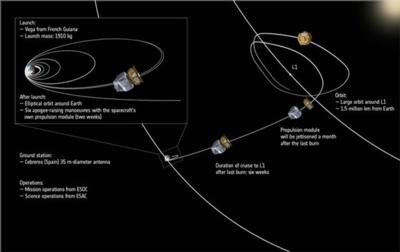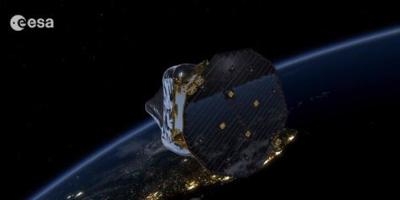Fri, Dec 04, 2015
Successful Launch Thursday Boosted Instrument Into Orbit
LISA Pathfinder, a European Space Agency (ESA) science spacecraft, designed and built by Airbus Defense and Space, has been successfully placed into orbit from the Kourou European spaceport in French Guiana. The Vega launcher, operated by Arianespace, flawlessly lifted-off on 03 December at 04:04 GMT and released LISA Pathfinder, 105 minutes later. Spacecraft controllers in the European Space Operations Center have received LISA Pathfinder’s first signals.

LISA Pathfinder will spend two weeks raising its orbit using a dedicated propulsion module, also built by Airbus Defense and Space, through six separate engine firings. After the final escape burn is performed and the health of the spacecraft module is confirmed, the propulsion module will be jettisoned, approximately 51 days after launch.
The spacecraft will continue on its journey to the first Lagrange point (L1) at 1.5 million km (approx 930,000 miles) from Earth. Its operational orbit is a 500,000km x 800,000km (approx 310,000 x 500,000 mile) Lissajous orbit around the L1 point. During the drift phase, the platform and the two spacecraft propulsion systems (Cold Gas and the NASA Colloidal micronewton thrusters) will be tested and verified.
24 days after the separation, the mission will begin with three weeks commissioning of the science payload including tests such as the release and capture of the test masses, and verification of the Drag Free and Attitude and Control System (DFACS). This will be followed by the six-month long main mission.
LISA Pathfinder is paving the way for a future large space observatory that ultimately will directly observe and precisely measure gravitational waves. ESA selected the gravitational universe science theme for its third Large Class L3 mission, for which a LISA-like mission is a leading candidate. Gravitational waves will allow astronomers to study our universe in a new way, and future telescope systems will be able to observe exotic sources, such as colliding super-massive black holes, as never before.

Airbus Defense and Space in the UK was chosen by the European Space Agency (ESA) to build the spacecraft and propulsion module and is responsible for delivering the integrated satellite. Airbus Defense and Space in Germany was chosen by ESA and the German Aerospace Center, DLR, to be the systems leader for the LTP, which was developed with contributions from European research institutes and companies.
(Source: Airbus news release. Images from file)
More News
19-Year-Old Pilot Was Attempting to Fly Solo to All Seven Continents On his journey to become the first pilot to land solo on all seven continents, 19-year-old Ethan Guo has hit a >[...]
From 2017 (YouTube Edition): A Quality LSA For Well Under $100k… Aeroprakt unveiled its new LSA at the Deland Sport Aviation Showcase in November. Dennis Long, U.S. Importer>[...]
Hazardous Weather Information Summary of significant meteorological information (SIGMET/WS), convective significant meteorological information (convective SIGMET/WST), urgent pilot>[...]
Aero Linx: Historic Aircraft Association (HAA) The Historic Aircraft Association (HAA) was founded in 1979 with the aim of furthering the safe flying of historic aircraft in the UK>[...]
"We would like to remember Liam not just for the way he left this world, but for how he lived in it... Liam was fearless, not necessarily because he wasn't afraid but because he re>[...]
 TikToker Arrested After Landing His C182 in Antarctica
TikToker Arrested After Landing His C182 in Antarctica Classic Aero-TV: Versatile AND Practical - The All-Seeing Aeroprakt A-22 LSA
Classic Aero-TV: Versatile AND Practical - The All-Seeing Aeroprakt A-22 LSA ANN's Daily Aero-Term (06.27.25): Hazardous Weather Information
ANN's Daily Aero-Term (06.27.25): Hazardous Weather Information ANN's Daily Aero-Linx (06.27.25)
ANN's Daily Aero-Linx (06.27.25) Aero-News: Quote of the Day (06.27.25)
Aero-News: Quote of the Day (06.27.25)




